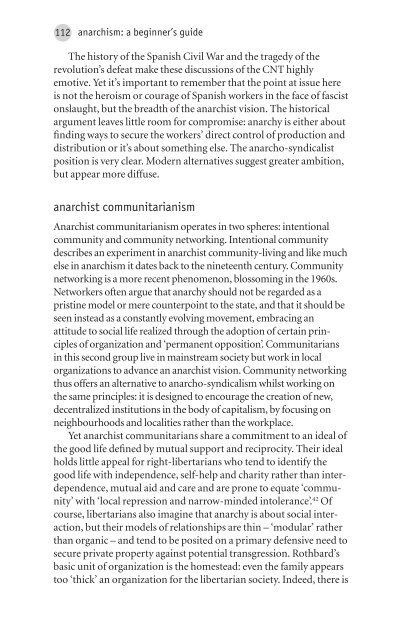o_195qg5dto17o4rbc85q1ge61i84a.pdf
Create successful ePaper yourself
Turn your PDF publications into a flip-book with our unique Google optimized e-Paper software.
112<br />
anarchism: a beginner’s guide<br />
The history of the Spanish Civil War and the tragedy of the<br />
revolution’s defeat make these discussions of the CNT highly<br />
emotive. Yet it’s important to remember that the point at issue here<br />
is not the heroism or courage of Spanish workers in the face of fascist<br />
onslaught, but the breadth of the anarchist vision. The historical<br />
argument leaves little room for compromise: anarchy is either about<br />
finding ways to secure the workers’ direct control of production and<br />
distribution or it’s about something else. The anarcho-syndicalist<br />
position is very clear. Modern alternatives suggest greater ambition,<br />
but appear more diffuse.<br />
anarchist communitarianism<br />
Anarchist communitarianism operates in two spheres: intentional<br />
community and community networking. Intentional community<br />
describes an experiment in anarchist community-living and like much<br />
else in anarchism it dates back to the nineteenth century. Community<br />
networking is a more recent phenomenon, blossoming in the 1960s.<br />
Networkers often argue that anarchy should not be regarded as a<br />
pristine model or mere counterpoint to the state, and that it should be<br />
seen instead as a constantly evolving movement, embracing an<br />
attitude to social life realized through the adoption of certain principles<br />
of organization and ‘permanent opposition’. Communitarians<br />
in this second group live in mainstream society but work in local<br />
organizations to advance an anarchist vision. Community networking<br />
thus offers an alternative to anarcho-syndicalism whilst working on<br />
the same principles: it is designed to encourage the creation of new,<br />
decentralized institutions in the body of capitalism, by focusing on<br />
neighbourhoods and localities rather than the workplace.<br />
Yet anarchist communitarians share a commitment to an ideal of<br />
the good life defined by mutual support and reciprocity. Their ideal<br />
holds little appeal for right-libertarians who tend to identify the<br />
good life with independence, self-help and charity rather than interdependence,<br />
mutual aid and care and are prone to equate ‘community’<br />
with ‘local repression and narrow-minded intolerance’. 42 Of<br />
course, libertarians also imagine that anarchy is about social interaction,<br />
but their models of relationships are thin – ‘modular’ rather<br />
than organic – and tend to be posited on a primary defensive need to<br />
secure private property against potential transgression. Rothbard’s<br />
basic unit of organization is the homestead: even the family appears<br />
too ‘thick’ an organization for the libertarian society. Indeed, there is




